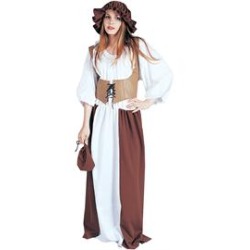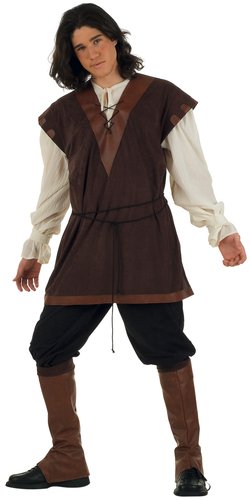Okay, first up, we got us a human male, lower class. Lets start from the head and work our way down.
Personally, I have not read many if anything about a peasant wearing a hood. It’s plausible, but men generally wore straw hats in the summer, and wool hats in the winter. However, it does look cool (cooler than a straw hat), so don't be afraid to add it to your costume.
He’s wearing a tunic that comes to above his knees. This tunic has sleeves, but they can be sleeveless, too. Underneath would be a shirt. Around his waist is a rope he uses as a belt. On his belt he ties on important farm tools, his money pouch, even good luck charms.
On the bottom, typically they either wore pants, with knee high socks. Or they would wear tights, but what they wore was often uncomfortable.
Now, I want you to pay close attention to the feet. Often, peasants in the medieval times could not afford shoes. They would walk around bare foot in the fields. A cheaper alternative is what you see there. It’s a piece of leather, the same shape of his foot, but about 3 inches bigger around. A long bit of leather was weaved around the edges like a money pouch. A flat piece of wood is put in the middle of the leather, put his foot on the wood, pull on the leather cord, and there you go! You got yourself a shoe. Just wrap up the extra around your ankles.
~~~~~~~~~~~~~~~~~~~~~~~~~~~~~~~~~~~~~~~~~~~~~~~~~~~~~~~~~~~~~~~~~~~~~~~~~~~~~~~~~~~~~~~~~~~
Next up we got the female. We’ll go from the head down again.
As you have probably noticed, she has a cloth wrapped around her head. That is her chin kerchief. The first picture better demonstrates how they were worn. Women also wore a plain square or round piece of cloth on her head, fastened by string.Not covering your head in public was not socially acceptable at the time. The only women who did that were single women and prostitutes.
Women also wore tunics (kirtles), but they were much longer then men’s. Almost dress like. Past the knees and almost to the ankles, and long sleeves. Slits were cut up the sides of the tunic to allow for more movement. They also may have worn a long tunic, with the long sleeves tied at the wrists and a shorter tunic overtop. The lacing you see could have been in the front or back. The point of it was to pull the fabric closer to the woman's waist, making it more form fitting. Her dress you see here is roughly what the layering tunics would look like. Underneath, she would wear stockings or tights. She’s in the same boat at men when it comes to shoes. If she was lucky to afford anything, it would be the bits of leather and wood wrapped around her feet and ankles.
**All materials used to make peasant clothing was made from low quality wool or rare occasions, linnin
Here are some more commoner costumes and outfits to help give you ideas. Some of it leaks into the Renaissance period, but at SR, that's perfectly fine. Your costume can be Renaissance inspired, too.







